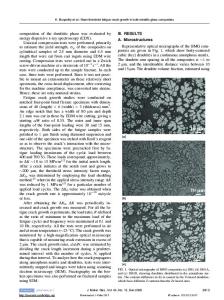Fracture toughness and fatigue crack growth in rapidly quenched Nb-Cr-Ti In situ composites
- PDF / 3,260,849 Bytes
- 12 Pages / 612 x 792 pts (letter) Page_size
- 55 Downloads / 317 Views
I.
INTRODUCTION
IN situ composites formed by heat treatment from a number of Nb-Cr-Ti compositions have been found to exhibit enhanced fracture resistance at ambient temperature.[1,2,3] The materials examined in those studies were made by conventional solidification methods, and in some cases, the cast materials were also forged to refine the cast structure. Detailed studies of the fracture processes revealed that the Cr2Nb particles fractured during both fatigue crack growth and fast fracture. The amount of crack bridging by the Nb solid solution alloy was either small or nonexistent. When bridging existed, the plastic flow within the ligaments was very localized. As a result, the crack-wake ligaments fractured easily without giving rise to a resistance-curve behavior. The lack of plastic flow in the crack-wake ligaments was attributed to the microstructural constraint imposed on the Nb phase by the Cr2Nb. It was thus hypothesized that refinement of microstructure to produce smaller intermetallic particles that did not fracture or impose as large a microstructural constraint might increase the fracture resistance of the material. Therefore, rapid solidification was sought as a method to refine the size of the microstructural elements of these composites. In addition to microstructure, the fracture resistance of Nb-Cr-Ti solid solution alloys and in situ composites depends sensitively on the Cr and Ti contents.[2] For the solid solution alloys, with ,15 at. pct Cr, fracture toughness values increased with increasing Ti content and reached a maximum KQ value of '80 MPa=m at '37 at. pct Ti.[2] A further increase in Ti addition led to a rapid decrease in fracture toughness. For the Nb-Cr-Ti in situ composites, the dependence of the fracture toughness on Ti content is less K.S. CHAN and D.L. DAVIDSON, Institute Scientists, are with Southwest Research Institute, San Antonio, TX 78228-0510. D.L. ANTON, Senior Research Scientist, is with United Technologies Research Center, East Hartford, CT 06108. Manuscript submitted November 27, 1996. METALLURGICAL AND MATERIALS TRANSACTIONS A
drastic but qualitatively similar. The maximum fracture toughness reached is 20 MPa=m at '30 pct Ti.[2] These beneficial effects of Ti on fracture toughness have also been observed in the Nb-Al-Ti ternary system.[4] For the NbCr-Ti system, the range of Ti where fracture toughness enhancement occurs is '32 to 42 pct Ti for the solid solution alloys and '28 to 35 pct Ti for the in situ composites. Thus, the Ti content of the Nb-Cr-Ti in situ composites must be controlled when microstructural effects on fracture resistance are studied. This article reports the results of the microstructural and fracture evaluations of rapidly solidified (RS) composites. The compositions of these composites were approximately the same compositions as those previously found to exhibit high fracture toughness. The results for the RS composites will be compared to previous results for conventionally processed composites to assess whether refinement of Cr2Nb particle
Data Loading...











